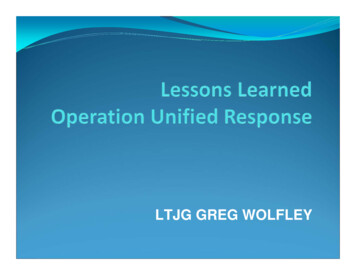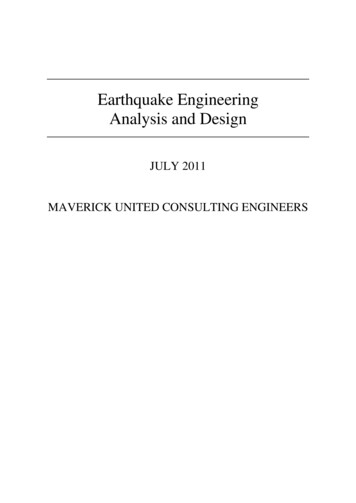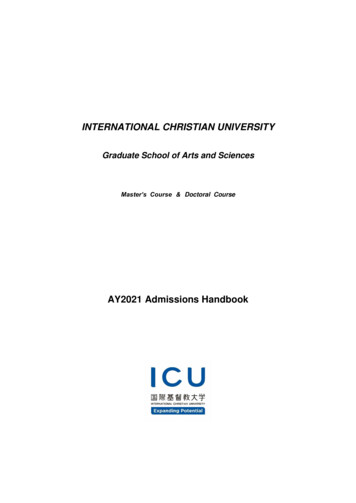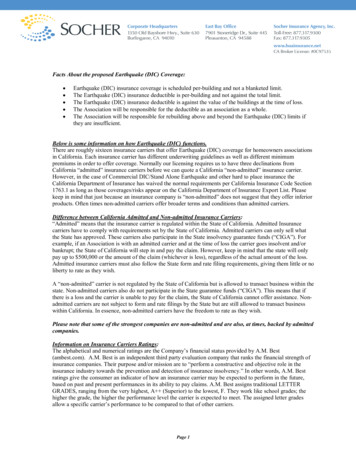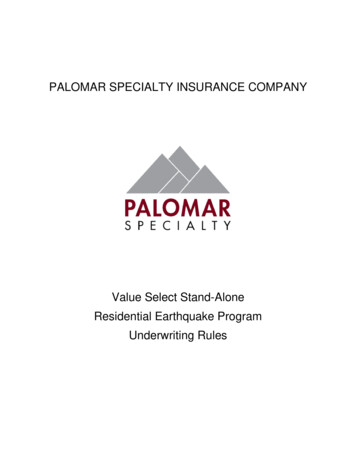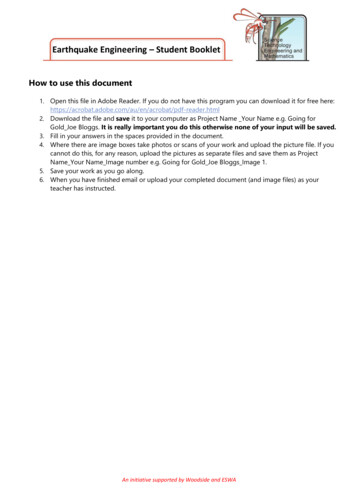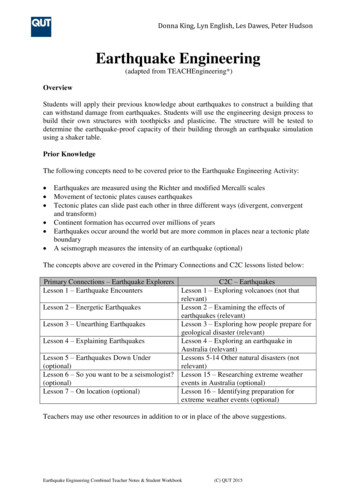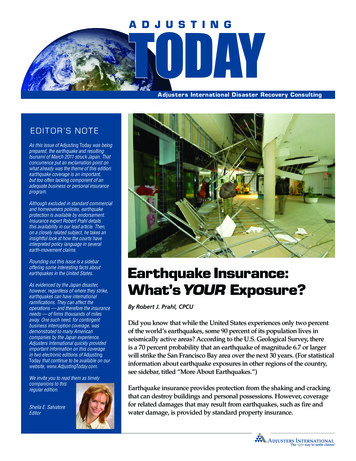
Transcription
Adjusters International Dis aster Recovery ConsultingEDI T OR’S NO T EAs this issue of Adjusting Today was beingprepared, the earthquake and resultingtsunami of March 2011 struck Japan. Thatconcurrence put an exclamation point onwhat already was the theme of this edition:earthquake coverage is an important,but too often lacking component of anadequate business or personal insuranceprogram.Although excluded in standard commercialand homeowners policies, earthquakeprotection is available by endorsement.Insurance expert Robert Prahl detailsthis availability in our lead article. Then,on a closely related subject, he takes aninsightful look at how the courts haveinterpreted policy language in severalearth-movement claims.Rounding out this issue is a sidebaroffering some interesting facts aboutearthquakes in the United States.As evidenced by the Japan disaster,however, regardless of where they strike,earthquakes can have internationalramifications. They can affect theoperations — and therefore the insuranceneeds — of firms thousands of milesaway. One such need, for contingentbusiness interruption coverage, wasdemonstrated to many Americancompanies by the Japan experience.Adjusters International quickly providedimportant information on this coveragein two electronic editions of AdjustingToday that continue to be available on ourwebsite, www.AdjustingToday.com.We invite you to read them as timelycompanions to thisregular edition.Sheila E. SalvatoreEditorEarthquake Insurance:What’s Your Exposure?By Robert J. Prahl, CPCUDid you know that while the United States experiences only two percentof the world’s earthquakes, some 90 percent of its population lives inseismically active areas? According to the U.S. Geological Survey, thereis a 70 percent probability that an earthquake of magnitude 6.7 or largerwill strike the San Francisco Bay area over the next 30 years. (For statisticalinformation about earthquake exposures in other regions of the country,see sidebar, titled “More About Earthquakes.”)Earthquake insurance provides protection from the shaking and crackingthat can destroy buildings and personal possessions. However, coveragefor related damages that may result from earthquakes, such as fire andwater damage, is provided by standard property insurance.
A D J U S T I N GT O D A YUnlike flood insurance, earthquake coverage isavailable from most private insurance companiesrather than from the government — except inCalifornia, where homeowners can also obtaincoverage from the California Earthquake Authority(CEA). Commercial structures are not eligible forcoverage from the CEA.Coverage for the Earthquake Exposure:Commercial Property CoverageEarthquake insurance is expensive and in locationswith high or severe exposure to loss by this peril,availability may be somewhat limited. This is trueparticularly in California and in states near the NewMadrid Fault, which include parts of Arkansas,Illinois, Indiana, Kentucky, Mississippi, Missouri,and Tennessee. In other areas of the countryearthquake insurance is generally available but maynot be considered necessary, which for some can beunfortunate. As pointed out in the accompanyingsidebar, “More About Earthquakes,” in the past100 years earthquakes have occurred in 39 states.Earthquake damage is excluded in the standardhomeowners and commercial property insurancepolicies of Insurance Services Office (ISO) and theAmerican Association of Insurance Services (AAIS).The following excerpt from the earth movementexclusion (with the concurrent causation languagelead-in) is found in the ISO Basic, Broad, and SpecialCauses of Loss forms CP 10 10 06 07, CP 10 20 06 07,and CP 10 30 06 07 of the commercial property policy.1B. Exclusions1. We will not pay for loss or damage causeddirectly or indirectly by any of the following.Such loss or damage is excluded regardlessof any other cause or event that contributesconcurrently or in any sequence to the loss.b. Earth Movement(1) Earthquake, including any earth sinking,rising or shifting related to such event;(2) Landslide, including any earth sinking,rising or shifting related to such event;(3) Mine subsidence, meaning subsidence ofa man-made mine, whether or not miningactivity has ceased;(4) Earth sinking (other than sinkholecollapse2), rising or shifting including soilconditions which cause settling, crackingor other disarrangement of foundationsor other parts of realty. Soil conditionsinclude contraction, expansion, freezing,thawing, erosion, improperly compactedsoil and the action of water under theground surface.But if Earth Movement, as described in b. (1)through (4) above, results in fire or explosion, wewill pay for the loss or damage caused by thatfire or explosion.(5) Volcanic eruption, explosion or effusion.But if volcanic eruption, explosion oreffusion results in fire, building glassbreakage or Volcanic Action, we will payfor the loss or damage caused by that fire,building glass breakage or Volcanic Action.The AAIS exclusion reads as follows:b. Earth Movement or Volcanic Eruption — We donot cover loss caused by any earth movement(other than sinkhole collapse) or caused byeruption, explosion, or effusion of a volcano.2ADJUSTINGT O D A Y. C O M
A D J U S T I N GT O D A YEarth movement includes, but is not limited to,earthquake; landslide; mudflow; mudslide; minesubsidence; or sinking, rising, or shifting of earth.We cover direct physical loss by fire, explosion,or volcanic action resulting from either earthmovement or eruption, explosion, or effusion ofa volcano.All volcanic eruptions that occur within a 168hour period shall be considered a single loss.3Adding Earthquake CoveragePremiums for earthquake coverage differ widely bylocation, insurer, distance from fault lines, and the typeof structure that is covered. Generally, older buildingscost more to insure than new ones. Wood frame structuresgenerally benefit from lower rates than brick buildingsbecause they tend to withstand quake stresses better.ISO offers two endorsements to add earthquakeand volcanic eruption coverage under commercialproperty insurance. Independently filed earthquakeendorsements are also available from some insurers.The two ISO endorsements are:(1) Earthquake and Volcanic Eruption Endorsement— CP 1040(2) Earthquake and Volcanic Eruption Endorsement(Sub-Limit Form) — CP 1045The first endorsement provides coverage for the fullpolicy limit and contains a coinsurance clause. Thesecond provides coverage subject to a sublimit that islower than the base policy limit and it does not containa coinsurance clause.AAIS offers an endorsement similar to the ISOendorsements that provides earthquake and volcaniceruption coverage. Both the AAIS and ISO forms statethat all earthquakes or volcanic eruptions that occurwithin a 168-hour period will be considered a singleoccurrence and that the 168-hour period is not limitedby the policy expiration.ADJUSTERSINTERNATIONAL.COMIn addition, both forms include a potential limitationthat in the AAIS form reads as follows:Masonry Veneer — “We” do not cover loss toexterior masonry veneer (other than stucco)on wood frame walls caused by earthquake orvolcanic eruption. The value of masonry veneeris not included in the value of covered propertyor the amount of loss when applying:1. The deductible that is applicable to this PerilsPart; or2. The coinsurance applicable to the CommercialProperty Coverage.However, “we” cover masonry veneer whendescribed as included on the “declarations” orwhen it is less than 10 percent of the exterior wallarea.4Although coverage for collapse is limited to specificperils in standard property insurance policies, theISO Earthquake Endorsement includes coverage forcollapse caused by earthquake or volcanic eruption.However, there is no coverage for damage causeddirectly or indirectly by tidal wave or tsunami, evenif attributable to an earthquake or volcanic eruption.Businesses would need flood insurance to pay forthe flood damage caused by a tsunami or tidal wave.In addition, coverage does not apply to loss causedby requirements for building code upgrades, unlessordinance or law coverage is added by endorsement.Business Interruption CoverageThe business interruption exposure from a loss causedby earthquake is significant. Commercial firms mustcarry business interruption coverage as part of theircommercial property insurance if they want thatcoverage to apply in the event of an earthquake.Business interruption coverage is only triggered if thereis a covered property loss, so insureds with exposureto earthquake loss need to carry both businessinterruption and earthquake coverage.3
A D J U S T I N GT O D A YDeductible IssuesThe earthquake deductible generally is in the form ofa percentage rather than a dollar amount. Deductiblescan range anywhere from 2 percent to 20 percent of thevalue of the property (e.g., replacement value or actualcash value, whichever is applicable) of the structure.Insurers in Washington, Nevada and Utah, with higherthan average risk of earthquakes, often set minimumdeductibles at around 10 percent. In most casesconsumers can get higher deductibles to save moneyon earthquake premiums.The deductible provisions of ISO’s earthquakeendorsement apply to each earthquake or volcaniceruption. It is important to note that separatedeductibles are calculated for and apply to eachbuilding, to personal property at each building, and topersonal property in the open.Deductibles are calculated separately and applied even iftwo or more buildings sustain damage, personal propertyat two or more buildings sustains damage, or a buildingand the personal property in it sustain damage.If, in addition to earthquake damage, there is alsodamage from another cause (such as fire) that iscovered through an exception to the earth movementexclusion in the base policy, then the earthquakedeductible is the only deductible taken. It will besignificantly higher than the base policy deductible.The ISO earthquake endorsement contains an exampleof the application of the deductible as follows:5(Assume values shown are from the most recentStatement of Values on file with the insurer.)Building #1Building #2Bus. Per. Prop. at Bldg. #1Bus. Per. Prop. at Bldg. #2 500,000 Value of Property 500,000 250,000 250,000Assume that the following amounts of loss do notexceed the applicable limits of insurance (for specificinsurance). Also assume that the total amount ofloss does not exceed the applicable blanket limit ofinsurance (for blanket insurance).Building #1 and business personal property at #1 havebeen damaged: the amounts of loss are 95,000 (Bldg.)and 5,000 (Per. Prop.). The deductible is 10 percent.The percentage deductible provision is significant.Though the deductible is 10 percent, it is not10 percent of the loss, but rather 10 percent of thevalue of the property (RC or ACV).Loss is adjusted as follows:“The exposureto loss byearthquakemay be moresignificantthan peoplerealize.”4Bldg.Step (1): 500,000 (amt. of ins.) x 10% 50,000 deductible amt.Step (2): 95,000 (loss) minus 50,000 45,000Bus. Per. Prop.Step (1): 250,000 (amt. of ins.) x 10% 25,000 deductible amt.The loss of 5,000 does not exceed the deductible.The most that will be paid is 45,000. The remainderof the building loss, 50,000, is not covered due toADJUSTINGT O D A Y. C O M
A D J U S T I N GT O D A Yapplication of the deductible. There is no loss paymentfor the business personal property because the damageis under the deductible.ConclusionIn an effort to spread risk, insurers and governmentagencies are using reinsurance, state and private pools,Fair Access to Insurance Requirements (FAIR) plans,and trading options on a catastrophe index that theChicago Board of Trade maintains. However, more isneeded, according to ISO. Consequently, many insurersadvocate a proposal put forth by the Natural DisasterCoalition. This proposal provides for: Mandatory coverage of hurricanes, earthquakes,volcanoes, and tsunamis, at actuarially sound rates A federal reinsurance program Incentives for state governments to develop lossmitigation programsThe exposure to loss by earthquake may be moresignificant than people realize. Organizations needto check periodically with their insurance advisorsto ensure that their insurance coverage realisticallymeets their exposures.Earthquake insurance is also available with aDifference in Conditions (DIC) policy, the topicplanned for a future issue of Adjusting Today.1Copyright, Insurance Services Office, Inc. 2007, with permission.2Sinkholecollapse (collapse of land into underground spaces created by theaction of water on limestone or similar rock formations), which is commonin Florida and Pennsylvania, is covered by the commercial property policiesof AAIS and ISO. The peril is covered in AAIS homeowner forms, but is notcovered in ISO homeowner forms, but may be added by endorsement. In somestates the coverage is required by law.3Copyright, American Association of Insurance Services, Inc., 2000, withpermission.4Copyright, American Association of Insurance Services, Inc., 2007, withpermission.5Copyright, Insurance Services Office, Inc., 1998, with permission.Courts Have Made a DistinctionEarth Movement: Man-Made vs. Natural CausesSince this issue of Adjusting Todayfocuses on earthquake insurance,it seems fitting to include arelated subject that can likely beencountered in earth movementclaims. That subject has to do withcausation, and particularly whetheran earth movement claim involvesloss or damage caused by naturalevents, which are often widespreadand catastrophic, or loss or damagecaused by man-made activity,which usually is more confined.Although property insurancepolicies contain earth movementADJUSTERSINTERNATIONAL.COMexclusions, the courts havesometimes held for coverage whenthe cause of the earth movementcan be attributed to man-madeactivities, while excluding loss fromnatural events, i.e., earthquake,related earth sinking or shifting, ormudslide. For example, buildingdamages caused by nearby blastingactivities or excavation on anadjacent lot that resulted in settling,sinking, and cracks and separationsin the foundations were consideredto be man-made activities and heldto be covered, despite the earthmovement exclusion.Whether coverage applies typicallydepends on how the exclusion isworded, and particularly on theexistence and/or strength of theanti-concurrent causation lead-inlanguage to the exclusions. Formany years, the Insurance ServicesOffice (ISO) and the AmericanAssociation of Insurance Services(AAIS) have included anticoncurrent causation languagein their commercial property,businessowners, and homeownerspolicies. Essentially, the doctrineof concurrent causation holds thatwhen a loss can be attributed to5
A D J U S T I N GT O D A Ytwo causes, one that is covered andone that is excluded, the loss willbe covered. It applies primarilyto “all risks” or “open perils”policies. Insurers then counteredthe concurrent causation doctrine,which in many instances resulted intheir paying claims that were nevercontemplated in their premiumstructure to be covered, by addingan anti-concurrent causationprovision to the exclusions section.That provision clarified that therewas no coverage for loss causedby an excluded peril (flood,earthquake, etc.), regardless ofany other cause that contributedconcurrently or in any sequence tothe loss.While current standard propertyforms of ISO and AAIS containthis provision, non-standard orindependently filed policies maynot, or may contain their ownversions of this provision.Reviewing court decisionsthat involve the issue ofman-made vs. natural earthmovement losses can beinstructive by providinginsights on how courtsanalyze the issue and theinsurance language that isapplicable to the loss.Court DecisionsThe first case is Fayad v.Clarendon National Ins.Co., 899 So.2d 1082, 2005WL 729172, (Fla. 2005).1The plaintiffs had an allrisks property policy thatcontained an earth movementexclusion. The claim involved6nearby blasting activity thatcaused structural damage to theirhome. Clarendon denied the claimon the basis that blasting wasearth movement and, therefore,excluded. The pertinent provisionin the Clarendon policy read asfollows:We do not insure for losscaused directly or indirectlyby any of the following. Suchloss is excluded regardlessof any other cause or eventcontributing concurrently or inany sequence to the loss.The earth movement exclusion read:Earth Movement, meaningearthquake, including landshock waves or tremors before,during or after a volcaniceruption; landslide; minesubsidence; mudflow; earthsinking, rising or shifting; unlessdirect loss by: fire or explosionensues and then we will payonly for the ensuing loss.The trial court decided in favorof Clarendon based on the rulingin another case, State Farm Fire &Casualty Co. v. Castillo, 829 So.2d242 (Fla. 3d DCA 2002). In thatcase, the court held that the lead-inlanguage of the exclusions clearlyruled out coverage. State Farm’slead-in provision read:We do not insure under anycoverage for any loss whichwould not have occurred in theabsence of one or more of thefollowing events. We do notinsure for such loss regardlessof: (a) the cause of the excludedevents or (b) other causes of theloss or (c) whether other causesacted concurrently or in anysequence with the excludedcoverage“ Whetherapplies typicallydepends on how theexclusion is worded,and particularly onthe existence and/orstrength of the anticoncurrent causationlead-in language tothe exclusions.”ADJUSTINGT O D A Y. C O M
A D J U S T I N GT O D A Yevent to produce the loss; or(d) whether the event occurssuddenly or gradually, involvesisolated or widespread damage,arises from natural or externalforces, or occurs as a result ofany combination of these.Note that the (d) part of thisprovision refers to both natural aswell as external forces.The court in the Castillo caseconcluded that based on thislanguage, the policy clearly andunambiguously excluded the earthmovement loss, regardless of thecause. The trial court in Fayadfollowed this reasoning, despitethe fact that the lead-in languageto the exclusions in each policyread differently.The plaintiff appealed to the DistrictCourt on the basis that theexclusionary language in theClarendon policy was materiallydifferent from the exclusion in theState Farm policy. While agreeingthat the Clarendon exclusion wasmuch narrower, the District Courtnevertheless upheld the ruling of thetrial court. The plaintiff then appealedto the Florida Supreme Court.Without including all the details ofthe Supreme Court’s analysis, themain points of the Court’s rulingwere as follows: (1) There is adistinction between losses causedby man-made events and naturalcauses; (2) Where an earthmovement exclusion does notcontain language excluding earthmovement regardless of its cause,ADJUSTERSINTERNATIONAL.COMthe majority of courts conclude thatthe exclusion only applies to earthmovement caused by natural causes;(3) The principle of ejusdem generis,meaning that where a policy listsseveral events (such as mudslide,earthquake, volcano) and then listsa broader event (earth sinking, risingor shifting), the court will interpretthe broader events as applying tothe same kind or class as those thatare specifically mentioned.The Florida Supreme Courtconcluded that there was no specificlanguage in the Clarendon policythat excluded earth movementregardless of cause (despite thelead-in language of the Clarendonpolicy), and that the policy listedseveral natural events in itsdefinition of “earth movement.”As a result, the Court overturnedthe District Court and ruled thatthe policy covered damage causedby blasting. The Court furtherstated that if Clarendon intendedto exclude damage from earthmovement caused by man-madeevents, it should have done soclearly and unambiguously.It is also noteworthy that the Courtcommented that even thoughClarendon would be paying forthe plaintiff’s damage, it couldseek recovery against the blastingcompany through subrogation.In Pioneer Tower Owners Assn.v. State Farm Fire & Casualty Co.2009 NY Slip Op 03409 (Court ofAppeals)2, the plaintiff made claimfor damage to its condominiumbuilding that was caused byexcavation on an adjacent lot. StateFarm denied the claim citing theearth movement exclusion.When cracks appeared in thebuilding, an engineer was called inand concluded that the cracks andseparations in the building werecaused by the excavation workon the adjacent lot. The engineerattributed damage to the buildingto flawed underpinning that wasbuilt by the excavating company toprotect the plaintiff’s foundation,and that as a result, earth slid awayfrom beneath the building causingthe damage.State Farm’s anti-concurrent causeprovision was the same as thatshown in the Castillo case, exceptfor part (d). (Emphasis added.) Theearth movement exclusion in theState Farm policy read as follows:Earth movement, meaningthe sinking, rising, shifting,expanding or contracting ofearth, all whether combinedwith water or not. Earthmovement includes but isnot limited to earthquake,landslide, erosion, andsubsidence but does notinclude sinkhole collapse.State Farm also relied on the settlingor cracking exclusion which read:We do not insure for loss eitherconsisting of, or directly andimmediately caused by, oneor more of the following:f. settling, cracking, shrinking,bulging or expansion.In deciding this case, the Courtnoted that the law governing7
A D J U S T I N GT O D A Yinterpretation of insurance policyexclusionary clauses is highlyfavorable to insureds, and citedSeaboard Sur. Co. v. Gillette Co.64 NY2d 304 1984 which saidessentially that:Whenever an insurer wishes toexclude certain coverage fromits policy, it must do so in clearand unmistakable language andany exclusions must be accordeda strict and narrow constructionand must not be subject toanother reasonable interpretation.State Farm argued that the earthmovement exclusion appliedbecause the loss was caused by themovement of earth, and specificallyby its sinking and shifting beneaththe plaintiff’s building. It alsocontended that the settling orcracking exclusion applied becausethe loss consisted of cracking thatwas directly and immediatelycaused by the settling of thebuilding (which was in turn causedby the excavation).The plaintiff, on the other hand,contended that a literal readingof the words does not give themeaning that an ordinary personwould assign to these exclusionaryclauses. As to the earth movementexclusion, plaintiff pointed tothe examples of earth movementgiven in the policy of earthquake,landslide, erosion and subsidence.The plaintiff’s position was thatan excavation — the intentionalremoval of earth by humans — isa different kind of event from anearthquake and the other examples8given, and suggested that whenspecific examples are mentioned,those not mentioned should beunderstood to be things of the samekind (ejusdem generis).The plaintiff contended that ifthe drafter of the policy languagein question intended to bringexcavation within the exclusion,it should have been listed as anexample of the perils not covered.Similarly, the plaintiff argued thatthe settling or cracking exclusionwould not be thought by anordinary person to apply to settlingor cracking that is the immediateand obvious result of some otherevent, such as the intentionalremoval of earth in the vicinity ofthe building.After considering both arguments,the Appeals Court concluded thatboth the plaintiff’s and defendant’spositions were reasonable.However, the Court added thatthe precedents require the policyinterpretation to narrow theexclusions, and result in coverage.It also cited two Appellate Divisioncases and one Federal DistrictCourt decision that have held thatthe earth movement exclusions,using identical language, are notapplicable to losses caused byexcavation. (Lee v. State Farm Fire& Cas. Co., 32 AD3d 902 [2d Dept.2006]; Burack v. Tower Ins. Co. of N.Y.,12 AD3d 167 [1st Dept. 2004]; Wyattv. Northwestern Mut. Ins. Co. of Seattle,304 F. Supp. 781 [D Minn. 1969].)Accordingly, coverage was affordedthe plaintiff in this case.In the case of Castillo v. State FarmFire & Casualty Company, 32 FLWD2474a (Fla. 3rd DCA October 17,2007)3, nearby blasting createdshockwaves and vibrations thatdamaged the plaintiff’s dwellingwithout actual displacement orpermanent displacement of theearth. (This case has no relationto State Farm Fire & Casualty Co. v.Castillo discussed previously whichheld that coverage did not apply.)The case involves the identical,strong State Farm anti-concurrentcause language that was quoted inthe State Farm v. Castillo casebeginning on page 6 and the earthmovement exclusion that wascontained in the Pioneer TowerOwners Assn. v. State Farm decisiondiscussed previously. In Castillo v.State Farm, the allegations in thecomplaint were that vibrations andshockwaves caused by blastingwithout displacement of the earthresulted in the damage to theplaintiff’s dwelling. The Court thennoted that the policy does notspecifically address whether or notdamages caused by blasting,shockwaves, or vibrations fall under“earth movement” and would,therefore, be excluded fromcoverage. The Court went on to saythat when the terms of the contractare ambiguous and susceptible todifferent interpretations, parolevidence4 is admissible to explain,clarify or elucidate the ambiguousterm.The Court then sought furtherinformation to determine whetherthe exclusion applied in this case byADJUSTINGT O D A Y. C O M
A D J U S T I N GT O D A Ylooking at State Farm’s internaloperating guidelines. Inreviewing those guidelines,the Court found a reference tothe effect that damage fromblasting, crane or demolitionequipment, etc., cannot occurunless the earth moves.Therefore, the Court reasonedthat coverage will be providedfor blasting that causesshockwaves/vibrationstransmitted through the earthto the plaintiff’s dwellingwhich causes damage withoutdisplacement of the earth. Inconclusion, the Court determinedthat the plaintiff could proceed to ajury because the question ofwhether or not the shockwaves andvibrations alleged by the Castillosdamaged their dwelling withoutdisplacement of the earth was anissue of material fact. The Courtalso noted that once the plaintiffestablishes a loss apparently withinthe terms of an all risks policy, theburden shifts to the insurancecompany to prove that the loss arosefrom a cause which is excluded.In Totty v. Chubb Corp., 455 F. Supp.2d 376 (W.D. Pa. 2006)5, the Court,applying Pennsylvania law, heldthat the earth movement exclusionin the homeowner’s insurancepolicy did not clearly excludedamage caused by man-madeforces and, therefore, denied theinsurer’s motion for summaryjudgment.The plaintiff alleged that herproperty was damaged becauseof the densification of sandADJUSTERSINTERNATIONAL.COMlayers in the underlying soilthat resulted from the use of avibratory compactor to repavethe adjacent street in July 2002.Damage included cracked walls,damaged door frames, plumbingleaks, and the sinking of one sideof her home. Although the case isidentified as Totty v. Chubb Corp.,the claim was initially denied byGreat Northern Insurance Co.,a member of the Chubb Group,whose policy insured Totty. Tottysubsequently filed suit against bothChubb Corp., the parent company,and Great Northern. Hence, thereferences to Great Northernthroughout the discussion. GreatNorthern contested the plaintiff’stheory of causation, but argued thateven under that theory, the loss wasnot covered because it fell withinthe policy’s earth movement andstructural movement exclusions.The earth movement exclusionin Great Northern’s policy wassimilar to the exclusionarylanguage previously cited in theaforementioned cases.The Court reasoned that on onehand, the exclusion bars coveragefor natural events, i.e., earthquakesand volcanic eruptions. On theother hand, it bars coverage forevents which can be natural,man-made or both, i.e., landslide,mudflow, earth sinking, rising orshifting. Although it is arguablethat the exclusion is applicable toearth movement due to natural andman-made events, a reasonableperson could conclude that theexclusion is applicable to earthmovement due to natural eventsonly. Since the earth movementexclusion is reasonably susceptibleto different constructions, it isimpossible to determine the intentof the parties as manifested by thewritten language of the contract ofinsurance.Relying on this ambiguity and theprinciple of ejusdem generis, theCourt held that the plaintiff’s policyexcluded coverage only for naturalearth movements. The Court furtherheld that Great Northern could have9
A D J U S T I N GT O D A Yeasily excluded earth movementcaused by man-made events.The cases reviewed previously,except for State Farm Fire & CasualtyCo. v. Castillo, held for coverage.However, in Cali v. MerrimackMut. Fire Ins. Co., 2007 NY Slip Op06415 (Appellate Division, SecondDept.)6, the Court ruled that theearth movement exclusion appliedto rule out coverage. A portion ofthe plaintiff’s home collapsed whenthe concrete slab foundation settled,sank, and cracked. Merrimackdenied the claim based on the policylanguage that excluded losses dueto earth movement, earth sinking,rising or shifting and settling,shrinking, bulging, or expansion,including resultant cracking ofpavements, patios, foundations, etc.The plaintiff’s engineer concludedthat the slab foundation partiallycollapsed as a result of decayedwood in the earth beneath thefoundation, which caused a void inthe soil and the eventual collapse.The Court held that Merrimack metits initial burden of establishingthat the exclusion clearly andunambiguously applied to the loss.The Court also made referenceto language which stated thatlosses due to earth movement areexcluded regardless of any other causeor event contributing concurrently orin any sequence to the loss. Here, theloss was attributable to the resultantearth movement
is a 70 percent probability that an earthquake of magnitude 6.7 or larger will strike the San Francisco Bay area over the next 30 years. (For statistical information about earthquake exposures in other regions of the country, see sidebar, titled "More About Earthquakes.") Earthquake insurance provides protection from the shaking and cracking
